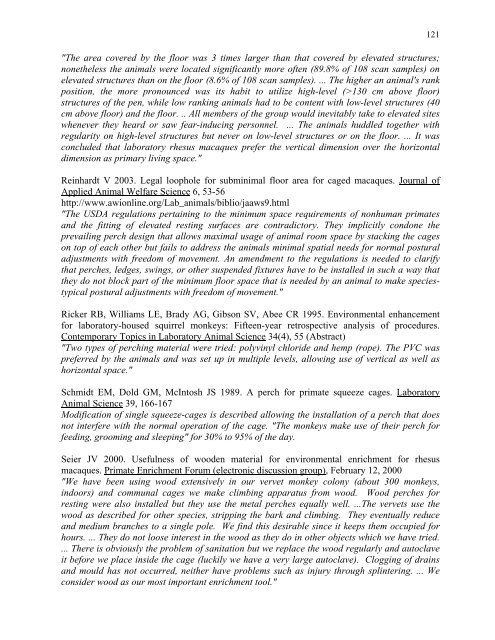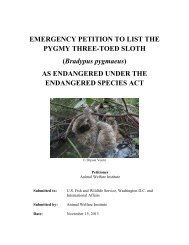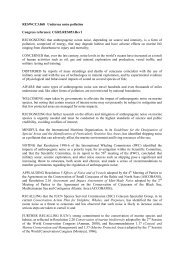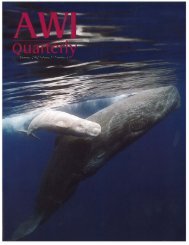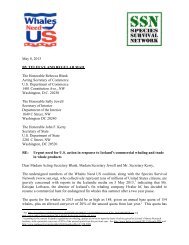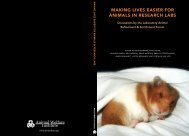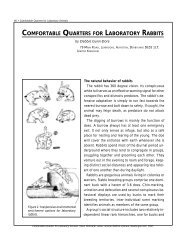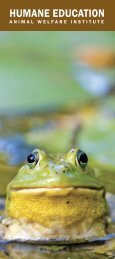"The area covered by the floor was 3 times larger than that covered by elevated structures;nonetheless the animals were located significantly more often (89.8% of 108 scan samples) onelevated structures than on the floor (8.6% of 108 scan samples). ... The higher an animal's rankposition, the more pronounced was its habit to utilize high-level (>130 cm above floor)structures of the pen, while low ranking animals had to be content with low-level structures (40cm above floor) a<strong>nd</strong> the floor. .. All members of the group would inevitably take to elevated siteswhenever they heard or saw fear-i<strong>nd</strong>ucing personnel. ... The animals huddled together withregularity on high-level structures but never on low-level structures or on the floor. ... It wasconcluded that laboratory rhesus macaques prefer the vertical dimension over the horizontaldimension as primary living space."<strong>Re</strong>inhardt V 2003. Legal loophole <strong>for</strong> subminimal floor area <strong>for</strong> caged macaques. Journal ofApplied Animal Welfare Science 6, 53-56http://www.awionline.org/Lab_animals/biblio/jaaws9.html"The USDA regulations pertaining to the minimum space require<strong>ment</strong>s of nonhuman prim<strong>ates</strong>a<strong>nd</strong> the fitting of elevated resting surfaces are contradictory. They implicitly co<strong>nd</strong>one theprevailing perch design that allows maximal usage of animal room space by stacking the cageson top of each other but fails to address the animals minimal spatial needs <strong>for</strong> normal posturaladjust<strong>ment</strong>s with freedom of move<strong>ment</strong>. An ame<strong>nd</strong><strong>ment</strong> to the regulations is needed to clarifythat perches, ledges, swings, or other suspe<strong>nd</strong>ed fixtures have to be installed in such a way thatthey do not block part of the minimum floor space that is needed by an animal to make speciestypicalpostural adjust<strong>ment</strong>s with freedom of move<strong>ment</strong>."Ricker RB, Williams LE, Brady AG, Gibson SV, Abee CR 1995. <strong>En</strong>viron<strong>ment</strong>al enhance<strong>ment</strong><strong>for</strong> laboratory-housed squirrel monkeys: Fifteen-year retrospective analysis of procedures.Contemporary Topics in Laboratory Animal Science 34(4), 55 (Abstract)"Two types of perching material were tried: polyvinyl chloride a<strong>nd</strong> hemp (rope). The PVC waspreferred by the animals a<strong>nd</strong> was set up in multiple levels, allowing use of vertical as well ashorizontal space."Schmidt EM, Dold GM, McIntosh JS 1989. A perch <strong>for</strong> primate squeeze cages. LaboratoryAnimal Science 39, 166-167Modification of single squeeze-cages is described allowing the installation of a perch that doesnot interfere with the normal operation of the cage. "The monkeys make use of their perch <strong>for</strong>feeding, grooming a<strong>nd</strong> sleeping" <strong>for</strong> 30% to 95% of the day.Seier JV 2000. Usefulness of wooden material <strong>for</strong> environ<strong>ment</strong>al enrich<strong>ment</strong> <strong>for</strong> rhesusmacaques. <strong>Prima</strong>te <strong>En</strong>rich<strong>ment</strong> Forum (electronic discussion group), February 12, 2000"We have been using wood extensively in our vervet monkey colony (about 300 monkeys,i<strong>nd</strong>oors) a<strong>nd</strong> communal cages we make climbing apparatus from wood. Wood perches <strong>for</strong>resting were also installed but they use the metal perches equally well. ...The vervets use thewood as described <strong>for</strong> other species, stripping the bark a<strong>nd</strong> climbing. They eventually reducea<strong>nd</strong> medium branches to a single pole. We fi<strong>nd</strong> this desirable since it keeps them occupied <strong>for</strong>hours. ... They do not loose interest in the wood as they do in other objects which we have tried.... There is obviously the problem of sanitation but we replace the wood regularly a<strong>nd</strong> autoclaveit be<strong>for</strong>e we place inside the cage (luckily we have a very large autoclave). Clogging of drainsa<strong>nd</strong> mould has not occurred, neither have problems such as injury through splintering. ... Weconsider wood as our most important enrich<strong>ment</strong> tool."121
122Shimoji M, Bowers CL, Crockett CM 1993. Initial response to introduction of a PVC perch bysingly caged Macaca fascicularis. Laboratory <strong>Prima</strong>te Newsletter 32(4), 8-11http://www.brown.edu/<strong>Re</strong>search/<strong>Prima</strong>te/lpn32-4.html#pvcThe height of the cage is important <strong>for</strong> allowing the animals to withdraw from potentiallystressful or alarming situations. “Monkeys spent significantly more time clinging to the cagewall in the absence of the perch. ... Monkeys in lower level cages [26% of daytime] averagedsomewhat more time on the perch than those in upper cages [14% of daytime]. ... There was lessstereotypy when the perch was present."Smith K, St. Claire M, Byrum R, Harbaugh S, Harbaugh J, Erwin J 2003. Use of space, cagefeatures, a<strong>nd</strong> manipulable objects by laboratory prim<strong>ates</strong>: i<strong>nd</strong>ividual differences a<strong>nd</strong> speciesvariability. American Journal of <strong>Prima</strong>tology 60(Supple<strong>ment</strong>), 76-77 (Abstract)”Rhesus (74%), longtailed (71%), vervets (94%), a<strong>nd</strong> patas (82%) significantly exceeded theexpected rate of perch use (25%), while pigtailed (28%) did not differ from expectation.”Taylor LL 1998. Promoting species typical behavior in Coquerel's sifakas (PropithecusVerreauxi Coquereli). American Zoo a<strong>nd</strong> Aquarium Association <strong>Re</strong>gional ConferenceProceedings, 599-603"The sifakas rarely were observed on the grou<strong>nd</strong>, preferring to locomote on vertical substr<strong>ates</strong>a<strong>nd</strong> rest on vertical a<strong>nd</strong> horizontal elevated substr<strong>ates</strong>. ...If vertical surfaces were absent fromcaptive habitats, these rare lemurs could not display their preferred mode of arboreallocomotion.”Taylor L, Owens A 2004. <strong>En</strong>closure use by aged squirrel monkeys (Saimiri sciureus). AmericanJournal of <strong>Prima</strong>tology 62(Supple<strong>ment</strong>), 85http://www.asp.org/asp2004/abstractDisplay.cfm?abstractID=800&confEventID=808A group of squirrel monkeys was translocated from an i<strong>nd</strong>oor exhibit to an outdoor enclosure.“Static substr<strong>ates</strong> were preferred (64.3%). Dynamic substr<strong>ates</strong>, like rope walkways, were usedprimarily during locomotion (33.8%) from one static location to another.”van Wagenen G 1950. The monkeys. In The Care a<strong>nd</strong> Breeding of Laboratory Animals Farris EJ(ed), 1-42. John Wiley, New York, NY"Sitting on the board [approximately 1 m off the grou<strong>nd</strong>], facing the center of the room, is thefavorite position of the monkeys. At this height these intensely alert animals have a better view ofactivities within the room, a<strong>nd</strong> they can meet visitors on the same eye level. ... a<strong>nd</strong> they sleep onthe board at night."Watson DSB 1991. A built-in perch <strong>for</strong> primate squeeze cages. Laboratory Animal Science 41,378-379Perch installation design <strong>for</strong> single squeeze-back cages is described. "I<strong>nd</strong>epe<strong>nd</strong>ent of ge<strong>nd</strong>er themonkeys were seen using their perches more than 84% of the time."Watson SL, Shively CA 1996. Effects of cage configuration on behavior in cynomolgusmacaques. XVIth Congress of the Internatational <strong>Prima</strong>tological Society/XIXth Conference ofthe American Society of <strong>Prima</strong>tologists, Abstract No. 674"Stereotypies occurred more often in the STD [sta<strong>nd</strong>ard single cage] than in the VE [verticallyenhanced;probably with perche(s)]. ... The results i<strong>nd</strong>icate that VE cages provide more suitablei<strong>nd</strong>ividual housing environ<strong>ment</strong>s <strong>for</strong> nonhuman prim<strong>ates</strong> than STD cages."
- Page 3:
Table of ContentsSpecies-typical Be
- Page 7 and 8:
2Behavioral Pathologies (Abnormal B
- Page 9 and 10:
Meyerson BJ 1986. Ethology in anima
- Page 11 and 12:
6"An animal treated unsympathetical
- Page 13 and 14:
8"If sufficient room is not provide
- Page 15 and 16:
Canadian Council on Animal Care 198
- Page 17 and 18:
12Platt DM, Kinsey JH, Jorgenson MJ
- Page 19 and 20:
14(7) Enforced RestraintAdams MR, K
- Page 21 and 22:
16Goosen DJ, Davies JH, Maree M, Do
- Page 23 and 24:
Norman RL, McGlone J, Smith CJ 1994
- Page 25 and 26:
20Crockett CM, Bowers CL, Shimoji M
- Page 27 and 28:
22(10) Double-tier Cage Arrangement
- Page 29 and 30:
National Research Council 1998. The
- Page 31 and 32:
26Coe CL 1991. Is social housing of
- Page 33 and 34:
28Tatoyan SK, Cherkovich GM 1972. T
- Page 35 and 36:
30Line SW, Morgan KN, Markowitz H,
- Page 37 and 38:
32Reinhardt V 1989. Evaluation of t
- Page 39 and 40:
34Clarke AS, Juno CJ, Maple TL 1982
- Page 41 and 42:
36The animals “spent most time in
- Page 43 and 44:
38Brent L, Belik M 1997. The respon
- Page 45 and 46:
40"Access to the puzzles was accomp
- Page 47 and 48:
42"The purpose of this study was to
- Page 49 and 50:
44Choi GC 1993. Humans enrich the l
- Page 51 and 52:
46“Eleven baboons who had been si
- Page 53 and 54:
48Reinhardt V, Houser WD, Eisele S,
- Page 55 and 56:
50Thompson MA, Bloomsmith MA, Taylo
- Page 57 and 58:
(7) Working with Cooperative Animal
- Page 59 and 60:
54Lambeth SP, Hau J, Perlman JE, Ma
- Page 61 and 62:
56Smith M, Barley J, Down N, Franci
- Page 63 and 64:
Environmental Enrichment58(1) Defin
- Page 65 and 66:
60Baker KC, Seres M, Aureli F, de W
- Page 67 and 68:
62Judge PG, de Waal BM, Paul KS, Go
- Page 69 and 70:
(2,1,b) Group-housing: Group Format
- Page 71 and 72:
66McNary JK 1992. Integration of ch
- Page 73 and 74:
68Clarke MR, Blanchard JL 1994. All
- Page 75 and 76: Watts E 1997. Introductions. In Ora
- Page 77 and 78: 72Baumans V, Coke C, Green J, Morea
- Page 79 and 80: 74Hotchkiss CE, Paule MG 2003. Effe
- Page 81 and 82: 76Reinhardt V, Hurwitz S 1993. Eval
- Page 83 and 84: 78Shively CA 2001. Psychological we
- Page 85 and 86: 80“The establishment of dominance
- Page 87 and 88: 82Reinhardt V 1991. Agonistic behav
- Page 89 and 90: Abney D, Conlee K, Cunneen M, Down
- Page 91 and 92: 86Boccia ML, Broussard C, Scanlan J
- Page 93 and 94: Southey ER, Baldwin CM 2006. Social
- Page 95 and 96: T-W-Fiennes RN 1972. Primates - Gen
- Page 97 and 98: 927 to 44 training sessions. .. The
- Page 99 and 100: 94Baumans V, Coke C, Green J, Morea
- Page 101 and 102: 96Skoumbourdis EK 2008. Pole-and-co
- Page 103 and 104: 98Tamarins (Saguinus spp.)Smith TE,
- Page 105 and 106: 100Bertrand F, Seguin Y, Chauvier F
- Page 107 and 108: 102Gilloux I, Gurnell J, Shepherdso
- Page 109 and 110: 104Molzen EM, French JA 1989. The p
- Page 111 and 112: 106Reinhardt V 1992. Foraging for c
- Page 113 and 114: 108Boccia ML 1989. Long-term effect
- Page 115 and 116: 110Baumans V, Coke C, Green J, More
- Page 117 and 118: 112”We give our pair-housed cynos
- Page 119 and 120: 114use their hands to obtain and pr
- Page 121 and 122: 116MacLean E, Roberts Prior S 2006.
- Page 123 and 124: Bayne K, Hurst JK, Dexter SL 1992.
- Page 125: 120Phillippi-Falkenstein K 1998. Us
- Page 129 and 130: Anonymous 1991. The psychological w
- Page 131 and 132: 126Pruetz JD, Bloomsmith MA 1992. C
- Page 133 and 134: 128Reinhardt V 1990. Time budget of
- Page 135 and 136: 130O'Neill PL, Wright AC, Weed JL 1
- Page 137 and 138: 132above ground level. I very often
- Page 139 and 140: 134Canadian Council on Animal Care
- Page 141 and 142: 136International Primatological Soc
- Page 143 and 144: 138forage daily, by scattering food
- Page 145 and 146: 140sensory and emotional experience
- Page 147 and 148: 142Bayne K 1989 Resolving issues of
- Page 149 and 150: 144creation? Very unlikely!I think
- Page 151: 146Spaeth GL 1994. Editorial: Carin


